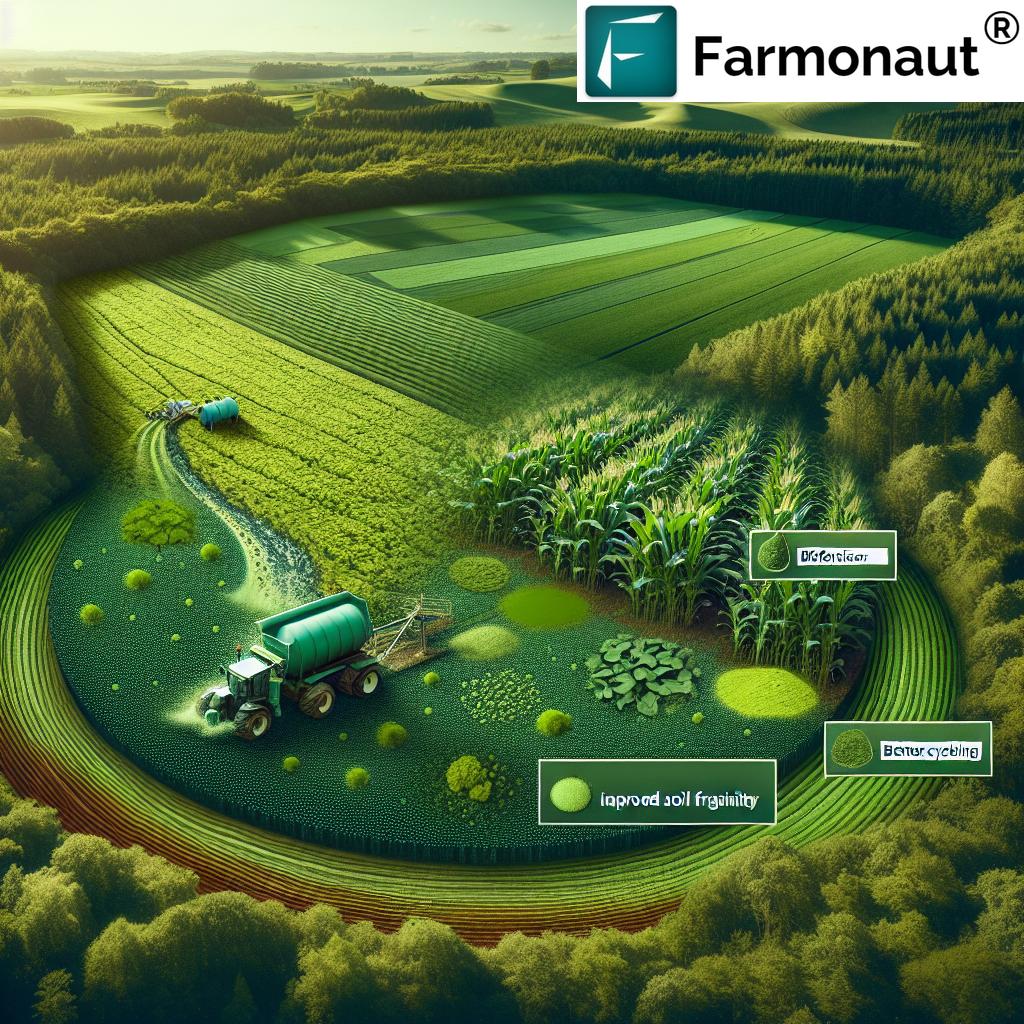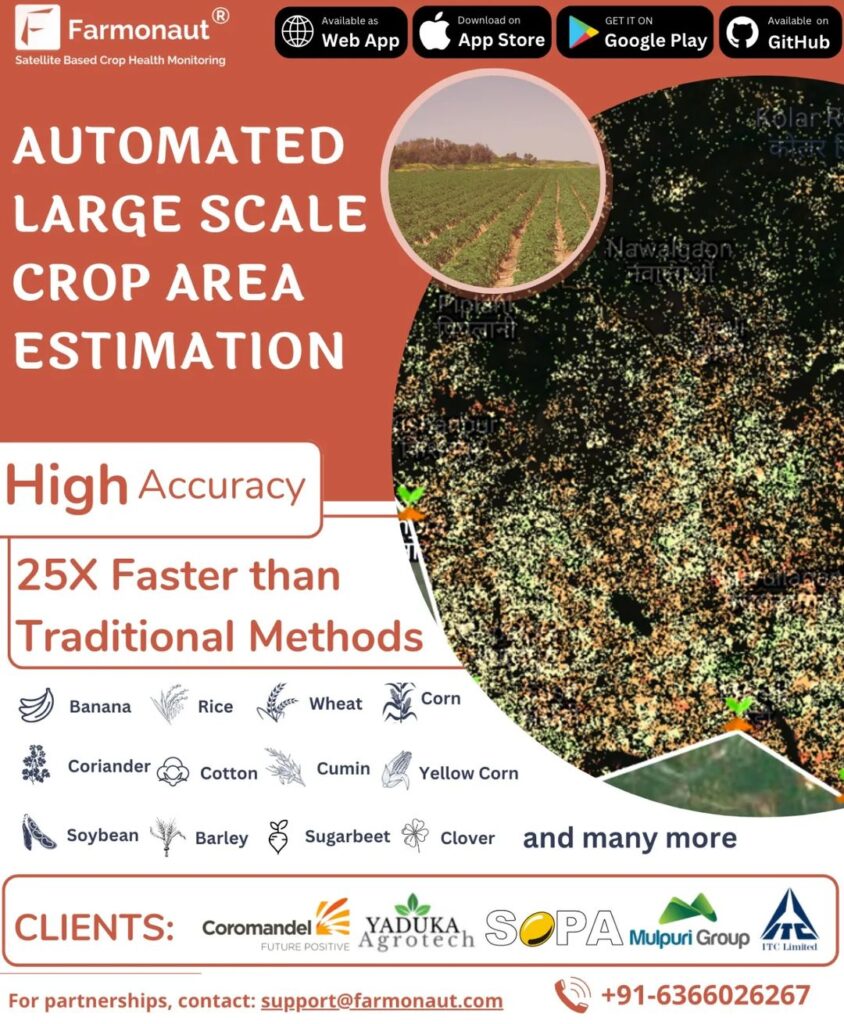Chlorella Solutions for Sustainable Agriculture & Forestry: Multifaceted Environmental Benefits
Summary:
Chlorella: A Multifaceted Asset in Agriculture, Farming, and Forestry
Chlorella, a genus of green microalgae, is making waves with its sustainable benefits across agriculture and forestry. From boosting soil health and nutrient cycling to efficiently treating wastewater and stimulating plant growth, Chlorella stands as a natural, eco-friendly solution to many challenges in modern and precision agriculture. In this in-depth guide, we’ll explore the nutritional benefits of Chlorella, its applications, environmental impact, and how leading technologies like Farmonaut help turn sustainable vision into reality.
Table of Contents
- Introduction to Chlorella in Agriculture and Forestry
- Nutritional Composition and Environmental Benefits of Chlorella
- Chlorella as a Biostimulant for Plant Growth Enhancement
- Chlorella Biofertilizer: Soil Health Improvement and Nutrient Cycling
- Chlorella Wastewater Treatment: Sustainable Practices in Agriculture
- Chlorella Applications in Forestry: Advancing Environmental Restoration
- Comparative Benefits Table: Chlorella’s Impact in Agriculture & Forestry
- Chlorella Cultivation and Sustainable Farming Practices
- Integrating Farmonaut’s Technology with Sustainable Chlorella Solutions
- Key Challenges and Opportunities for Chlorella Use
- FAQ: Chlorella in Agriculture and Forestry
- Farmonaut Subscription Options
- Conclusion
Introduction to Chlorella in Agriculture and Forestry
In the quest for sustainable agriculture and resilient environmental practices, Chlorella emerges as a green beacon. This unicellular microalgae genus is loaded with potent nutrients and versatile metabolites, delivering solutions to key challenges in farming and forest management. From soil regeneration to eco-friendly wastewater treatment, Chlorella’s multifaceted applications are gaining attention across the globe.
With increasing awareness of environmental impacts caused by chemicals and over-exploitation of resources, there’s a shift toward biologically-based interventions. Here, Chlorella in agriculture and forestry demonstrates how nature-based technologies anchor food production within sustainable, circular systems.
Nutritional Composition and Environmental Benefits of Chlorella
Chlorella’s promise lies in its bioactive nutritional content, which translates to robust environmental benefits in agriculture and forestry.
- Protein: Chlorella’s protein content ranges from 42% to 58% by dry weight, making it an exceptional plant-based protein source for food and function as a dietary supplement.
- Lipids & Fatty Acids: It contains 5–40% lipids, including essential omega-3 and omega-6 fatty acids.
- Carbohydrates: With 12–55% carbohydrate content, Chlorella stores significant energy value for plant and microbial processes.
- Minerals & Vitamins: Chlorella is packed with minerals (iron, magnesium, potassium, zinc) and vitamins (B, C, E).
- Pigments: The chlorophyll content (1–2%) and other pigments aid in plant metabolic functions.
- Bioactive Components: Amino acids, phytohormones, and polysaccharides support plant and microbial health.
These components contribute to Chlorella’s role as a functional ingredient—and when applied to soil or plants, they deliver cascading environmental and agricultural benefits.
Chlorella as a Biostimulant for Plant Growth Enhancement
The microalgae biostimulant effect of Chlorella is well-documented for plant growth enhancement. Multiple studies have shown that applications of Chlorella extracts or biomass stimulate a range of plant metabolic processes—including respiration, photosynthesis, and nutrient uptake.
Biostimulant Properties
- Chlorella’s metabolites—phytohormones, amino acids, polysaccharides—activate plant resilience.
- It stimulates germination rates, shoot and root length, and overall vigor.
- Treatments can boost crop yields by up to 20% in some cases, as seen in lettuce and cereal crops.
- Supports increased tolerance to abiotic stress (drought, salinity) and disease resistance.
These biostimulant effects make Chlorella a valuable supplement in sustainable farming practices and contribute to yield optimization.
Chlorella Biofertilizer: Soil Health Improvement & Nutrient Cycling
Maintaining soil health is a cornerstone for sustainable agricultural and forestry ecosystems. Chlorella biofertilizer has demonstrated remarkable results in this area.
Benefits of Chlorella Biofertilizer
- Soil Health Improvement with Chlorella: Improved microbial activity, increased organic matter, and enhanced nutrient cycling.
- Biofertilizer Potential: Chlorella is used either as dried biomass or in liquid form to rejuvenate degraded soils.
- Plant Growth Stimulation: Chlorella applications support shoot and root development for crops and seedlings.
- Rhizosphere Influence: Chlorella amendments promote beneficial microbial communities in the rhizosphere, supporting nutrient cycling and soil stabilization.
- Reduced Chemical Dependency: Integrating Chlorella-based biofertilizer into farming systems can decrease reliance on synthetic fertilizers and contribute to more sustainable outcomes.
For more details on biological solutions and carbon footprint reduction in farming, visit the Farmonaut Carbon Footprinting product page.
Chlorella Wastewater Treatment: Sustainable Practices in Agriculture
Agricultural runoff and contaminated irrigation water are growing threats to environmental health. Chlorella wastewater treatment offers natural, effective, and affordable solutions, making it a popular choice for sustainable farming practices.
How Chlorella Wastewater Treatment Works
- Pollutant Assimilation: Chlorella consumes excess nutrients (like nitrogen and phosphorus), heavy metals, and organic contaminants.
- Reduction of Pollutants: Studies have found that Chlorella-based systems can reduce pollutants by more than 60%, supporting environmentally cleaner water cycles.
- Circular Bioeconomy: Treated wastewater can be safely reused for irrigation, further boosting resource efficiency in sustainable agriculture.
With Chlorella, we can improve water quality and close nutrients loops—crucial for both large-scale farming and ecological forestry projects.
Chlorella Applications in Forestry: Advancing Environmental Restoration
While direct research on chlorella applications in forestry is ongoing, growing evidence supports its utility in forest soil remediation, ecosystem restoration, and seedling establishment.
Potential in Forestry Environments
- Soil Amendment: Chlorella biofertilizer can restore soil health in degraded forest lands, helping native trees establish better root systems and supporting biological stabilization.
- Nutrient Cycling: By promoting microbial activity and enhancing organic matter, Chlorella supports the re-establishment of a balanced forest ecosystem.
- Reforestation Aid: Eco-restoration strategies integrating Chlorella foster effective and environmentally responsible reforestation and afforestation.
This aligns with the objectives of Farmonaut’s Crop, Plantation, and Forest Advisory Solutions, which provide satellite-based insights to guide forest management and restoration actions.
Comparative Benefits Table: Chlorella’s Impact in Agriculture & Forestry
| Application Area | Estimated Environmental Benefit | Chlorella’s Role/Description | Sustainability Impact |
|---|---|---|---|
| Soil Health Improvement | +25% organic matter +30% microbial activity |
Biofertilizer amendments increase soil fertility and support beneficial microorganisms. | Eco-friendly fertilizer alternative; boosts soil biodiversity. |
| Plant Growth Enhancement | Up to 20% increase in crop yields; +15% root/shoot growth | Acts as biostimulant; delivers phytohormones and micronutrients for plant vigor. | Reduces need for synthetic growth enhancers; increases resilience. |
| Wastewater Treatment | 60–70% reduction in pollutants | Removes heavy metals and nutrients; enables water recycling. | Decreases chemical inputs to waterways; supports circular economy. |
| Forest Soil Restoration | +20% soil organic carbon | Rehabilitates degraded forestry soils; stimulates native plant rebound. | Accelerates reforestation; improves carbon sequestration. |
| Nutrient Cycling | Accelerated nutrient turnover | Promotes beneficial microbe populations; recycles essential minerals. | Enhances self-regenerating systems; lowers dependence on synthetic inputs. |
Chlorella Cultivation and Sustainable Farming Practices
Embracing not just sustainable applications but also sustainable production methods, Chlorella cultivation lends itself well to closed-loop, low-impact agricultural cycles.
- Closed-Loop Systems: Cultivation facilities can recycle water and nutrients, reducing environmental footprint.
- Integrative Approaches: Wastewater from farms can become a feedstock for Chlorella, which in turn produces biomass for biofertilizers, closing waste loops.
- Energy Efficiency: Use of renewable energy (solar, wind) in Chlorella production reduces carbon emissions.
All these characteristics embody the hallmarks of sustainable farming practices—circular bioeconomy, efficiency, and resource regeneration.
To track and optimize sustainability efforts, progressive farmers and agribusinesses rely on platforms like Farmonaut Carbon Footprinting Solutions for accurate, data-driven monitoring of their environmental impact.
Integrating Farmonaut: Smart Technologies for Chlorella-Boosted Sustainability
Harnessing the full potential of chlorella solutions demands advanced monitoring and decision-support technologies. This is where Farmonaut’s platform transforms the landscape of sustainable agriculture and forestry.
- Satellite-Based Crop Health Monitoring: Get real-time NDVI, soil moisture, and plant health data—empowering effective fertilization and resource management. Supports the Large Scale Farm Management module for vast operations.
- Jeevn AI Advisory: Receive AI-driven, personalized advisories on crop nutrition, pest management, and sustainable farming—including optimal biofertilizer use.
- Blockchain-Based Traceability: Use Product Traceability to ensure transparency and environmental compliance from farm to market for all eco-friendly agricultural inputs, including Chlorella-based products.
- Fleet and Resource Management: Optimize vehicle and resource deployment to support environmental targets with Fleet Management.
- Crop Loan & Insurance: Farmers using sustainable inputs may benefit from easier loan/insurance approvals; see Crop Loan & Insurance Solutions.
- API Access: Developers and agribusinesses can access real-time monitoring, weather, and ecosystem data through Farmonaut’s API and Developer Docs.
A synergy between biological solutions like Chlorella and data-driven resource optimization leads to scalable, measurable, and economically viable sustainable farming.
Key Challenges and Opportunities in Chlorella Use
While Chlorella is gaining rapid ground as a sustainable solution in agriculture and forestry, several challenges and considerations need to be acknowledged and addressed.
Challenges
- Scaling Up Production: Commercial, large-scale cultivation systems require capital and technological investment.
- Cost Considerations: Initial setup costs may be higher compared to conventional fertilizers—though the long-term benefits often outweigh these.
- Application Optimization: Dosage, frequency, and delivery methods need to be tailored for specific crops, soils, and regions.
- Research Needs: Further research is essential for fine-tuning chlorella applications in forestry and for region-specific best practices.
- Regulatory & Ecological Impacts: Responsible integration must consider broader ecological interactions and adhere to emerging regulatory frameworks.
Opportunities
- Global Sustainability Goals: Chlorella advances the UN Sustainable Development Goals (SDGs) on clean water, food security, and responsible production.
- Biodiversity: Supports the comeback of beneficial microorganisms and insects by restoring soil and ecosystem balance.
- Technological Integration: Enabling technologies—like those offered by Farmonaut—enhance tracking, reporting, and successful scaling of chlorella-based sustainable farming practices.
FAQ: Chlorella in Agriculture & Forestry
What is Chlorella and why is it important in agriculture?
Chlorella is a genus of single-celled, green microalgae loaded with proteins, carbohydrates, lipids, vitamins, minerals, and bioactive pigments. In agriculture, it acts as a powerful biostimulant, organic fertilizer, and pollutant remover, offering environmental benefits and sustainable growth solutions.
How does Chlorella improve soil health?
Chlorella increases organic matter, enhances microbial activity, and accelerates nutrient cycling, leading to more fertile and resilient soils. This, in turn, supports higher yields and sustainable cropping systems.
What plants benefit from Chlorella-based treatments?
A wide range—from cereals, vegetables (like lettuce), to tree seedlings. Chlorella aids growth, improves resilience, and may help combat abiotic stresses.
Can Chlorella help with wastewater management on farms?
Yes. Chlorella wastewater treatment absorbs and removes pollutants, enabling water recycling and reducing environmental contamination from agricultural activities.
How does Chlorella contribute to forestry practices?
It improves forest soil restoration, supports ecosystem rehabilitation, and increases reforestation success by strengthening nutrient cycling and soil microbial health.
Are there technologies that help optimize Chlorella applications?
Yes. Farmonaut provides real-time crop and soil health monitoring, advisory, and traceability solutions, helping farmers and foresters maximize Chlorella’s sustainable benefits across their operations.
Where can I learn more or access data on sustainable farming?
Visit Farmonaut or download the Farmonaut app for data-driven, satellite-based guidance on sustainable farming and forestry.
Farmonaut Subscription Options
To empower your journey in sustainable agriculture and maximize the value of chlorella-based solutions, explore Farmonaut’s range of subscription plans. Whether you’re a smallholder, a large-scale agribusiness, or part of a forestry initiative, scalable and affordable options are available to help you visualize, monitor, and optimize your land management.
Conclusion: Chlorella’s Pathway to Sustainable Agriculture & Forestry
As we strive towards a greener, more resilient future, Chlorella emerges as a critical asset for the world’s agricultural and forestry sectors. Its unique nutritional makeup, powerful biostimulant properties, and remarkable environmental benefits position it as a foundational building block for sustainable solutions.
When combined with cutting-edge data platforms like Farmonaut, we unlock the ability to monitor, trace, optimize, and scale Chlorella-driven sustainable farming practices anywhere on the globe. This not only fosters higher yields and improved soil health, but also propels us toward a regenerative, balanced, and eco-conscious bioeconomy.
Ready to boost your yields, restore ecosystems, and champion the future of sustainable agriculture? Try it now with the Farmonaut App or contact us for precision advisory tailored to your needs.






















